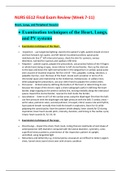Study guide
NURS 6512 Final Exam Review (WEEK 7-11) Heart, Lungs, and Peripheral Vascular Examination Techniques Of The Heart, Lungs, and PV systems |LATEST UPDATED VERSION
- Course
- NURS 6512 (NURS6512N)
- Institution
- Chamberlain College Of Nursng
NURS 6512N Final Exam Review (Week 7-11) – 36 Pages HEART, LUNGS, AND PERIPHERAL VASCULAR Examination techniques of the Heart, Lungs, and PV systems Examination techniques of the Heart: Examination-techniques of the lungs: Examination-techniques of the peripheral vascular system: Examination find...
[Show more]




